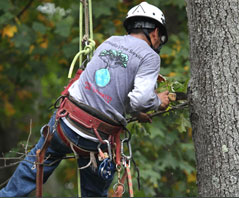Articles
Top Ten Tree Problems
Lace Bug
Lace bugs target broad-leaf evergreens such as andromeda, azalea, and rhododendron. Early detection is the key to getting rid of an infestation. Look for yellow-silver stippling on the topsides of leaves.
Mites
Mites pose a serious threat a wide variety of plants, and can seriously impact the visual appearance of a plant. Mites favor warm, dry climates, and are an extremely serious issue for many homeowners.
Tent Caterpillars
Caterpillars can weaken many trees and shrubs, increasing the chance of a secondary infestation. Look for silken, yellow cocoons.
Borers
Borers are attracted to unhealthy trees, burrowing in and laying eggs inside the trunk. The best defense against borers is to keep your trees healthy and unstressed.
Hemlock Woolly Adelgid
One of the most common pests, these insects can cause the death of a tree if left untreated. They leave behind a telltale white wax and target primarily older trees.
Scale Insects
These insects target primarily hardwoods and conifers. Some signs of an infestation include abnormal leaf and shoot growth, yellow or red leaves, and branch gouting.
Anthracnose Disease
This fungal disease affects deciduous and flowering trees. Look for a spotting of foliage in spring and summer.
Winter Injury
Even during mild winters, evergreens can lose moisture and not be able to replenish it. Thus, make sure your evergreens have sufficient soil moisture.
Weevil Insects
Weevils are commonly found on flowers and fruits. Look for notches around the edge of leaves.
Aphid Insects
Aphids are small and pearl shaped. An infestation can cause yellow discoloration and defoliation.
Tree Care Tips
Malnutrition
To avoid malnutrition, be sure to give your trees an adequate amount of micronutrients, such as magnesium sulfate, limestone, gypsum, iron, and zinc. However, trees need very limited amounts of these compounds, and an overabundance can be harmful. Have a certified arborist advise you on the correct amounts of each you should provide.
Frost Damage
Frost damage can be prevented if your trees’ leaves stay hydrated during a period of severe cold. Additionally, frequent watering and fertilization in anticipation of a cold night can also “harden” the cells of certain plants.
Borer Insects
Borer insects are very hard to anticipate or eliminate. The best defense is simply maintaining your tree’s general health so it can bounce back if it does develop an infestation.
Overwatering / Poor Drainage
Overwatering or poor drainage can cause root rot in your trees. Fungicides or manganese treatments can be effective as treatments or preventative measures.


